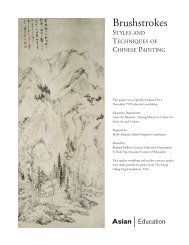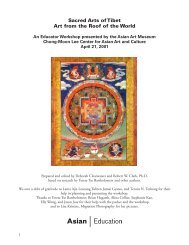Download PDF - Asian Art Museum | Education
Download PDF - Asian Art Museum | Education
Download PDF - Asian Art Museum | Education
You also want an ePaper? Increase the reach of your titles
YUMPU automatically turns print PDFs into web optimized ePapers that Google loves.
Introduction<br />
This workshop focuses on the Edo period (1615–1868) in Japan, and its rich artistic and<br />
cultural heritage. Teachers may chose to combine the slides and activities in this packet,<br />
which focus on courtly and literati arts, with other packets produced by the <strong>Asian</strong> <strong>Art</strong><br />
<strong>Museum</strong> and other institutions treating this period that are listed in the Bibliography.<br />
Teachers may also wish to borrow the museum’s activity trunk on Edo, which includes<br />
clothing of different classes, the Hokusai & Hiroshige slide packet, and introductory video<br />
on the Hokusai & Hiroshige exhibit.<br />
Notes to the reader<br />
Japanese names in this text will be listed following the Japanese convention. The family<br />
name precedes the given name, for example Ike Gyokuran, with Ike being the artist’s family<br />
name. However, unlike the Western practice—which commonly refers to artists by their last<br />
names (for example, Picasso or O’Keefe) Japanese artists are often referred to by their first<br />
names (for example, Gyokuran). One reason for this is that artists often changed their family<br />
name to that of their master or their artistic school (Kano Tanyu, for example). Since<br />
there have been hundreds of Kano artists, this name alone is not helpful in distinguishing<br />
Tanyu from other Kano artists, such as Kano Eitoku or Kano Hogai.<br />
Notes on pronunciation of Japanese words:<br />
Surprisingly to many English speakers, Japanese is not a very difficult language to pronounce.<br />
Most of the sounds, with a few exceptions, exist in English. Unlike English, Japanese<br />
does not have stress points within words nor does it have silent letters. Each syllable is<br />
given equal emphasis, and vowel sounds are standard. In English the letter “e” can sound<br />
very differently depending on the word, or it can be silent, (“eat” vs. “get” vs. “late”). Not so<br />
in Japanese. Each vowel has only one sound, which is always pronounced. Below is a basic<br />
guide to Japanese pronunciation.<br />
Sounds in Japanese are expressed in syllable-like units that generally consist of a consonant<br />
followed by a vowel, the three syllables: ki mo no, for example together make the word<br />
kimono (Japanese clothing).<br />
Vowels are pronounced as in the following English words:<br />
a as in at<br />
i as in machine<br />
u as in food (without rounding lips)<br />
e as in bet<br />
o as in orange<br />
<strong>Asian</strong> <strong>Art</strong> <strong>Museum</strong> <strong>Education</strong> Department
















